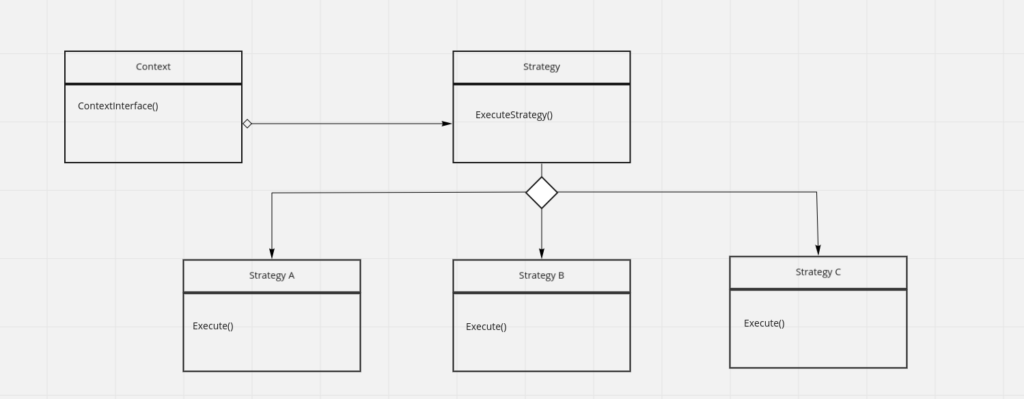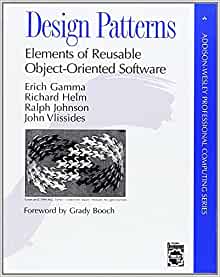The Strategy Pattern is a Behavioral Pattern , software Design Patterns defined by the Gang of Four in Design Patterns: Elements of Reusable Object-Oriented Software , it is also discussed in Head First Design Patterns.
The Strategy pattern enables the definition and encapsulation of a number of algorithms and make them interchangeable. The algorithms may vary independently and may deliver different outcomes and enable different behaviour, however they can all be called using the same method signature.
Design Patterns
Elements of Reusable Object-Oriented Software
23 patterns allow designers to create more flexible, elegant, and ultimately reusable designs without having to rediscover the design solutions themselves
A typical example of how the Strategy pattern is implemented is illustrated in the diagram below.

In Strategy pattern, a class behaviour or its algorithm can be changed at run time. Enabling the creation of objects which represent various strategies and a context object whose behaviour varies as per its strategy object. The strategy object changes the executing algorithm of the context object.
Another name for the Strategy pattern is *Policy*, which in my opinion provides a better clue on how this pattern can be utilised in software applications. The most common scenario in enterprise software development where the Strategy pattern can be implemented in a Business Rules Engine.
Define a family of algorithms, encapsulate each one and make them interchangeable. Strategy lets the algorithm vary independently from the clients that use it
Design Patterns
A business rules engine (BRE) is an application that manages decision processes using pre-defined logic to determine outcomes. BREs enable precise decision making, and are especially useful for complex dependencies, as well as in instances where regulatory or organisational rule changes frequently require logic changes.
An example of this may be in a Bank loan software application, there are various rules that can be triggered based on responses to questions. If the answer is yes to one question or no to another question, the chances of approval for a loan could be impacted or further subsequent questions may be required to further clarify financial information. These rules help guide users through the application process and help the financial institution determine the eligibility and structure their business.
I recently came across Basic Rules Engine Design Pattern, where in the author just actually describes the typical implementation of the Strategy pattern, as you'll be able to tell from the class diagram he supplied, the implementation resembles the simplified Strategy Pattern above.

Simplified Implementation
In our very simple implementation of the strategy pattern we'll build a simple console game, in which we'll invite the user to enter a number in the terminal and based on the value we'll return different values. Each of the return values will be returned by different strategies.
let's start by declaring an interface for our strategies, which we'll define as Rule which will have two methods a Verify and an Execute.
public interface IRule
{
bool Verify(string choice);
void Execute();
}
Essentially the Verfify method will taken in the input and determine if the strategy can be executed based on the input and provide a response back to calling application to signify whether it is appropriate to execute the strategy.
The Execute will enable the calling application to execute the strategy.
Lets implement a first simple strategy class implementing the interface. We'll implementing a strategy to ensure the user has provided a valid number as input, We'll name our class NotANumberRule.cs the code for the class will be as follows.
public class NotANumberRule : IRule
{
public bool Verify(string choice)
{
return !choice.All(char.IsDigit);
}
public void Execute()
{
Console.WriteLine("We said enter a number ");
}
}
I've kept the implementation of our class as simple as possible as not to distract from the detail of the strategy pattern. In the Verify method we iterate through each char in the supplied string to ensure that it is a Numeric digit, if we find any alpha characters then we want t signify that our strategy should be executed because we want to notify the user that they should only enter a number.
We can create any number of Rules classes providing the all implement the Rule interface. In the code sample I have implemented several rules each will trigger on various conditions.
We can now implement our simple Console application, in which we'll prompt the user to enter to choose a number between 1 and 10.
class Program
{
static void Main(string[] args)
{
string val;
Console.Write("Enter a number between 1 & 10 : ");
val = Console.ReadLine();
}
We now need to implement one more bit of code, which will basically retrieve all our Rules that we have defined in our application and determine which rule to execute based on the conditions.
We use a some Reflection to retrieve all types in our application and check to see if they implement the IRule interface, if they do we will instantiate the class and call the Verify method to determine if we should call the Execute method.
I have previously discussed using reflection in C# ,Get All C# Classes Implementing an Interface , the code below is slightly more lightweight implementation.
private static void ProcessInput(string input)
{
foreach (var type in Assembly.GetExecutingAssembly().GetTypes())
{
if (!typeof(IRule).IsAssignableFrom(type) || !type.IsPublic || type.IsInterface) continue;
var rule = (IRule)Assembly.GetExecutingAssembly().CreateInstance(type.FullName, false);
if (rule.Verify(input)) rule.Execute();
}
}
With this method now in place we can add it to our Console application.
static void Main(string[] args)
{
string val;
Console.Write("Enter a number between 1 & 10 : ");
val = Console.ReadLine();
ProcessInput(val);
}
If we attempt to run the application and attempt to enter any string that is not a number then we'll activate our NotANumber rule.

Let's extend our application and implement another rule, which specifies if the user enters a number 2, that a random snarky comment is generated.
public class SnarkyCommentRule : IRule
{
public bool Verify(string choice)
{
if (!choice.All(char.IsDigit)) return false;
var answer = Convert.ToInt32(choice);
return answer == 2;
}
public void Execute()
{
var index = new Random().Next(responses.Count);
Console.WriteLine(responses[index]);
}
private List<string> responses => new List<string>()
{
"To err is human to choose number 2 is plain stupid",
"Of all the numbers to choose you picked 2. Why?",
"A bird in the hand is worth 2 in the bush",
"You picked a couple of ones",
"Once bitten twice shy",
"An arch bishop Desmond",
"A vicar in a two two",
};
}
if we run our application and enter a two in the terminal we should now see one of our randomly selected responses displayed.

Conclusion
Using the Strategy pattern, a class behaviour or algorithm can be changed at run time. To implement the Strategy pattern, we create objects which represent various strategies and a context object whose behaviour varies as per its strategy object.
The strategy design pattern is not limited to a certain area of application. Instead, Any software that needs to solve pending tasks and problems with variability, behaviour options, and changes is a prime candidate for the design pattern.
- What is this Directory.Packages.props file all about? - January 25, 2024
- How to add Tailwind CSS to Blazor website - November 20, 2023
- How to deploy a Blazor site to Netlify - November 17, 2023

